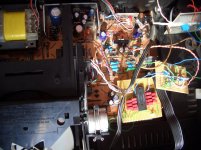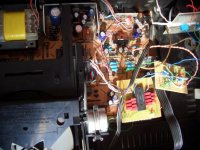-ve supply
Hi guys,
I could use some help. I'm building a small +ve -ve 5v supply using LM317/337s, rayreg design but using leds instead of R2.
+ve 5v is working fine. For the -5v I've got the combination of LEDs that give -5 but as soon as I add the 10u tant in parallel with them the voltage drops to 4.4/4.5 v. Same happens if I remove the leds and use a resistor. I've checked that I've got the -ve leg of the tant pointing towards R1/adj pin.
Any advice?
Thanks
Pete
Hi guys,
I could use some help. I'm building a small +ve -ve 5v supply using LM317/337s, rayreg design but using leds instead of R2.
+ve 5v is working fine. For the -5v I've got the combination of LEDs that give -5 but as soon as I add the 10u tant in parallel with them the voltage drops to 4.4/4.5 v. Same happens if I remove the leds and use a resistor. I've checked that I've got the -ve leg of the tant pointing towards R1/adj pin.
Any advice?
Thanks
Pete
funny - i had this same problem when i first built my stack of lm337 regs - as soon as the adj pin decoupling cap was fitted - the o/p voltage dropped to -4.5v ish !!
can't remember how i solved it now - I think I used an OSCON to start with but then changed to a poly - that might have done it - i'll go check and have a look!
can't remember how i solved it now - I think I used an OSCON to start with but then changed to a poly - that might have done it - i'll go check and have a look!
I've not used LEDs for R2, but my experience is that if the regulator is unloaded, the voltage tends to creep up slowly, and loaded, it is pulled down a little bit, depending on currrent. What happens if you try it with the correct resistances instead of using an LED?
I've not used LEDs for R2, but my experience is that if the regulator is unloaded, the voltage tends to creep up slowly, and loaded, it is pulled down a little bit, depending on currrent. What happens if you try it with the correct resistances instead of using an LED?
Hi Phil,
I get exactly the same problem if I use LEDs or a resistor.
Pete
I tried a load of things and nothing made any difference.
In the end I decided to connect them anyway (what's 1/2v between friends 🙂). Lo and behold the voltages came back up again. Disconnected and had another play. Seems the 337s don't behave without a cap on the output. Must be specific to the 337s, the 317s work on without one.
Anyway, all's ok now, thanks for all the help and advice.
Pete
In the end I decided to connect them anyway (what's 1/2v between friends 🙂). Lo and behold the voltages came back up again. Disconnected and had another play. Seems the 337s don't behave without a cap on the output. Must be specific to the 337s, the 317s work on without one.
Anyway, all's ok now, thanks for all the help and advice.
Pete
Hi Ian,
It sounds very smooth and natural, really very lovely. However, there's an occasional catastrophic emphasis on sibilants, which may not even be due to the output stage. I need to narrow down as I had also made some changes elsewhere in my system around the same time.
I will report when I know for sure.
Simon
It sounds very smooth and natural, really very lovely. However, there's an occasional catastrophic emphasis on sibilants, which may not even be due to the output stage. I need to narrow down as I had also made some changes elsewhere in my system around the same time.
I will report when I know for sure.
Simon
Sounds like a pain to trace that one!!!
I finally (after nearly 3 months) got the iron out again today!
I'd decided to try a direct hook up just using a single opamp (albeit Burson) for the I/V.
1st I hooked up the op of the Burson via a couple of Ampohms 4.7uF caps to test. The difference was obvious so I set about removing the valve stage and recovering the Mundorfs for DC blocking on the output.
Now the 1541 op's to a single Burson with 1.8k & 2n2 feedback then via 4.7uF to the phono socket (per channel obviously) I can confirm less is definately more!
While sorting this, Brent suggested I tried a mod on the already uber C2 clock. As all of the O/P's in the clock are buffered, he suggested that using T1 (directly connected to the xtal op) for the x1 clock op as it has been measured with lower jitter.
Yep! valve stage removed and cleaner clock signal again = More detail, wider soundstage with bags more depth, auccuracy and punch.
All for free! I like days like today
I finally (after nearly 3 months) got the iron out again today!
I'd decided to try a direct hook up just using a single opamp (albeit Burson) for the I/V.
1st I hooked up the op of the Burson via a couple of Ampohms 4.7uF caps to test. The difference was obvious so I set about removing the valve stage and recovering the Mundorfs for DC blocking on the output.
Now the 1541 op's to a single Burson with 1.8k & 2n2 feedback then via 4.7uF to the phono socket (per channel obviously) I can confirm less is definately more!
While sorting this, Brent suggested I tried a mod on the already uber C2 clock. As all of the O/P's in the clock are buffered, he suggested that using T1 (directly connected to the xtal op) for the x1 clock op as it has been measured with lower jitter.
Yep! valve stage removed and cleaner clock signal again = More detail, wider soundstage with bags more depth, auccuracy and punch.
All for free! I like days like today
Howdy Ian,
I'm not at all surprised to hear less is more here, that's great news for you!
Fascinating to hear about the C2, one to bear in mind when I upgrade to that nice clock.
Simon
I'm not at all surprised to hear less is more here, that's great news for you!
Fascinating to hear about the C2, one to bear in mind when I upgrade to that nice clock.
Simon
Sounds like a pain to trace that one!!!
I finally (after nearly 3 months) got the iron out again today!
I'd decided to try a direct hook up just using a single opamp (albeit Burson) for the I/V.
1st I hooked up the op of the Burson via a couple of Ampohms 4.7uF caps to test. The difference was obvious so I set about removing the valve stage and recovering the Mundorfs for DC blocking on the output.
Now the 1541 op's to a single Burson with 1.8k & 2n2 feedback then via 4.7uF to the phono socket (per channel obviously) I can confirm less is definately more!
While sorting this, Brent suggested I tried a mod on the already uber C2 clock. As all of the O/P's in the clock are buffered, he suggested that using T1 (directly connected to the xtal op) for the x1 clock op as it has been measured with lower jitter.
Yep! valve stage removed and cleaner clock signal again = More detail, wider soundstage with bags more depth, auccuracy and punch.
All for free! I like days like today
Hi,
Just in the middle of doing a single opamp set-up myself albeit with ordinary opamps at present. Just wanted to see if it would work. 🙂
Also lifted the 1541 to a seperate board to fit bigger/better decoupling caps. This on a Philips 373/473.
Hopefully it will all work when it goes back together.
Regards
Pete
Hi
If someone could send me service manual or complete schematic of Philips CD950 or Marantz CD273? Thanks.
JKoch
If someone could send me service manual or complete schematic of Philips CD950 or Marantz CD273? Thanks.
JKoch
Hi,
Just in the middle of doing a single opamp set-up myself albeit with ordinary opamps at present. Just wanted to see if it would work. 🙂
Also lifted the 1541 to a seperate board to fit bigger/better decoupling caps. This on a Philips 373/473.
Hopefully it will all work when it goes back together.
Regards
Pete
How have you got on Pete?
Partial success only at this stage.
Getting short periods of promising music interspersed with a lot of hum, noise, silence. Need to check all the grounds to the various new sections, I think they're the main cause of the problem.
I also seem to be getting a lot of DC on the output occasionally, even though I've got output caps fitted.
I'm planning to have another go this weekend.
Regards
Pete
Getting short periods of promising music interspersed with a lot of hum, noise, silence. Need to check all the grounds to the various new sections, I think they're the main cause of the problem.
I also seem to be getting a lot of DC on the output occasionally, even though I've got output caps fitted.
I'm planning to have another go this weekend.
Regards
Pete
Hi,
If any of you are still looking for a pristine CD650, I will bring mine to BAF in October and will not take it back, so it goes to whoever wants it and donates anything to diyaudio.com.
I also will include full service manual with schematics and pcb layouts.
Send me an email if you are interested.
jd
If any of you are still looking for a pristine CD650, I will bring mine to BAF in October and will not take it back, so it goes to whoever wants it and donates anything to diyaudio.com.
I also will include full service manual with schematics and pcb layouts.
Send me an email if you are interested.
jd
Hi,
got the earths sorted now. It's sounding quite good. Seems to be a much more noticable stereo effect than I'm used to on my CD67.
All needs tidying up/redoing with proper connections,maybe some new regs but I'll leave it like this for a while, make sure it's working properly first/
Pete
got the earths sorted now. It's sounding quite good. Seems to be a much more noticable stereo effect than I'm used to on my CD67.
All needs tidying up/redoing with proper connections,maybe some new regs but I'll leave it like this for a while, make sure it's working properly first/
Pete
Attachments
Only problem left now is that I get a bit of static and an echo of the last bit of the track at the end of each track before the mute kicks in.
Pete
Pete
Hi fellows,
another good thread to read... but so long! Yes I did it with the famous CD63's one 😉
And as I have some idea of what can be a good CD63 (CD53...) and will have a TDA1541A soon I wonder what I may expect.
In short the question is "will it be more involving and foot tapping?", and that without herculean works and risk of fried IC (wihc means fried player... )?
Matthieu
another good thread to read... but so long! Yes I did it with the famous CD63's one 😉
And as I have some idea of what can be a good CD63 (CD53...) and will have a TDA1541A soon I wonder what I may expect.
In short the question is "will it be more involving and foot tapping?", and that without herculean works and risk of fried IC (wihc means fried player... )?
Matthieu
- Home
- Source & Line
- Digital Source
- Philips CD650 mods

